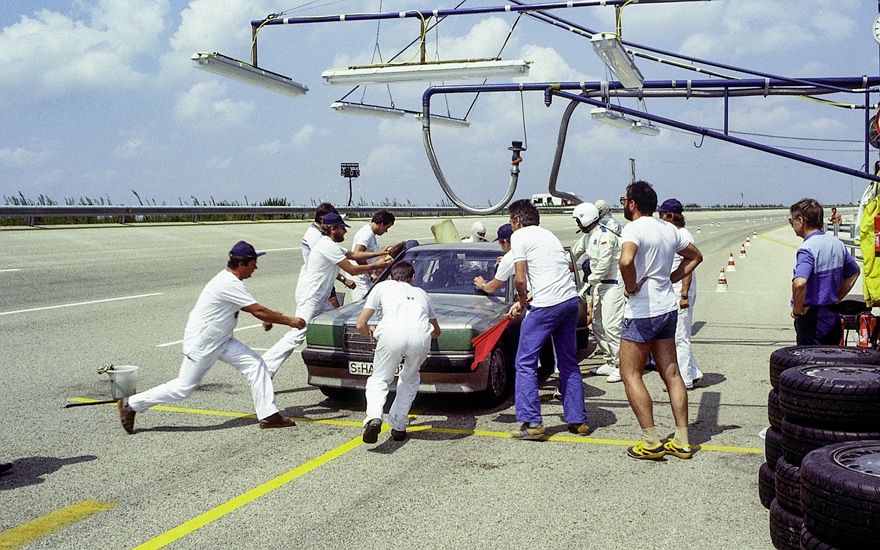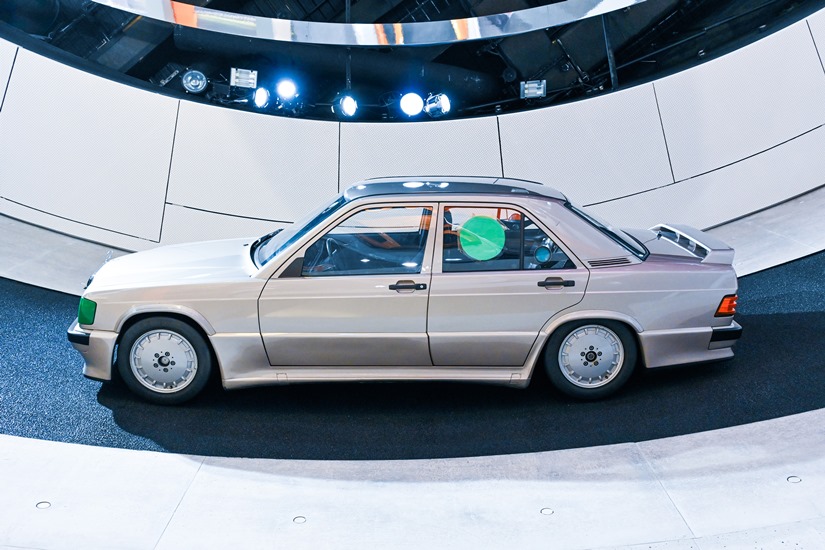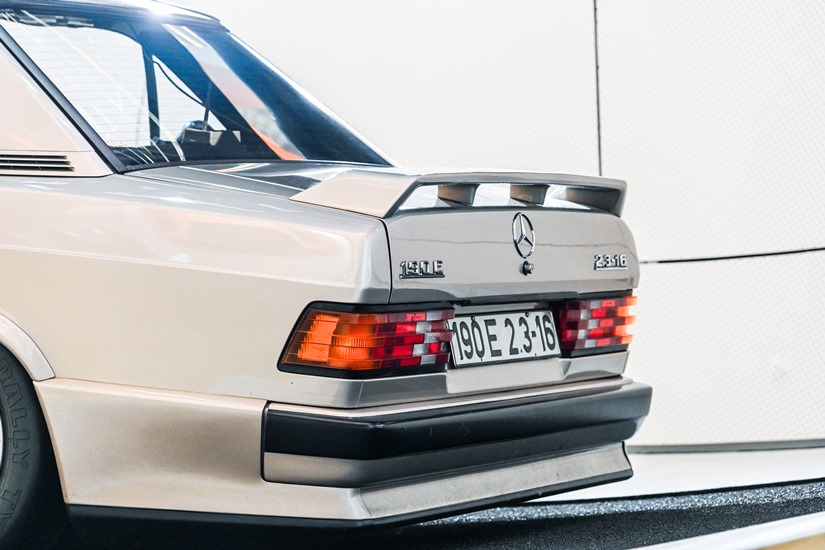
40 years ago, the Mercedes-Benz 190 E 2.3-16 set a record over 50,000 kilometres
Around the clock on the Nardò circuit, in outside temperatures of 40 degrees C
Impressive proof of reliability for the new engine with four-valve technology
Full service on the hot engine and tyre change in just five minutes
“Close-up” – the name of this series from the Mercedes-Benz Museum says it all. Each instalment tells a surprising, exciting or behind-the-scenes story, shining a spotlight on details of a vehicle, an exhibit or an architectural or design feature. In the spotlight this time: the Nardò record-breaking Mercedes-Benz 190 E 2.3-16 (W 201) of 1983.
No. 9/2023: Mercedes-Benz 190 E 2.3-16 (W 201) “Nardò record car” of 1983
View: The presentation is spectacular. At the end of the tour, seven record-breaking vehicles are to be seen mounted on the vertical wall of the Mercedes-Benz Museum. They form the end of the banked curve in Legend Room 7: Races and Records. In fourth position is the Mercedes-Benz 190 E 2.3-16 (W 201) Nardò record car of 1983. One of the vehicles that set a new world best time over 50,000 kilometres 40 years ago.
Original: The company sent three identical 190 E 2.3-16 to the Nardò circuit on that occasion. All of them crossed the finishing line. To reliably identify the teams at any time during the drive, the cars were colour-coded (green, red and white). The vehicle of the “green” team is on display at the Mercedes-Benz Museum. It has been preserved but not restored: a closer look reveals signs of use from back then.
Sports model: 40 years ago, the Mercedes-Benz 190 E 2.3-16 was the new top model in the W 201 series. Its four-valve engine was an entirely new feature: the four-cylinder unit had two intake and two exhaust valves per combustion chamber. It developed an output of 136 kW (185 hp) from a displacement of 2,299 cubic centimetres. The standard version of this sporty “Baby Benz” accelerated from 0 to 100 km/h in 7.5 seconds, and reached a top speed of 235 km/h. This made the sixteen-valve model a star in 1983.
Eight and a half days at 250 km/h: The three cars set several world records on the high-speed track in Nardò, southern Italy, between 13 and 21 August 1983. The fastest 190 E 2.3-16 covered a distance of 50,000 kilometres in 201 hours, 39 minutes and 43 seconds. The average speed was 247.9 km/h. In addition to this achievement, the trio set two more world records over 25,000 kilometres and nine class records.
Reliability: These records provided impressive proof of reliability over extreme distances for the cars, and especially for the four-valve engine of the “Baby Benz”. In this way, Mercedes-Benz was able to make the new engine technology popular. Around four weeks after the record drive, the company presented the 190 E 2.3-16 to the public for the first time at the International Motor Show (IAA) in Frankfurt/Main.
Modified: The record-breaking vehicles, which were capable of around 260 km/h, largely corresponded to the production version in terms of technology and appearance. This was especially true of the four-cylinder M 102 engines: they were standard power units with two overhead camshafts and 16 valves, and a standard output of 136 kW (185 hp).
Only the injection system and ignition were adapted to the special operating conditions, i.e. driving at a constant high load and an engine speed of around 6,000 rpm. In addition, there was a “performance” camshaft, a smaller radiator and no fan, because at these high driving speeds, the normal airstream was sufficient for a good flow through the radiator.

Aerodynamics: The radiator grille was covered with a quick-release insect screen to prevent clogging of the air ducts. To prevent the engine’s operating temperature from dropping in the lower night-time temperatures, a radiator louvre was also fitted, enabling up to two-thirds of the radiator to be covered from the driver’s seat. This further reduced aerodynamic drag as well. Other measures to optimise the aerodynamics included solid wheel rims and a 30-millimetre lowering of the suspension, as well as engine compartment and underbody cladding.
Less weight: The vehicles were also somewhat lighter. There was, for example, no reverse gear – since none was required. The steering was mechanical. This is because driving on the banked circuit practically eliminated lateral forces, i.e. it was almost always “straight ahead”, which meant that the power assistance envisaged for the standard version was not necessary. Instead of the rear seat, by the regulations, the record-breaking vehicles carried an assortment of the most important replacement and wear parts, e.g. air filter, oil filter, spark plugs, ignition cables and alternator. Repairs were only permitted using these parts.
Scary moment: A distributor arm had been omitted from the onboard parts supply because, after all, this is a component that usually holds up very reliably. But in the case of the “green” team’s vehicle on display at the Museum, it was precisely this component that fractured during the record drive.
This was a scary moment for the team led by Gerhard Lepler; but with great improvisational skill, the technicians and engineers managed to get the ignition going again. Even the damage to the underbody caused by a collision with a fox was unable to stop the “green” 190 E 2.3-16. As a result, all three vehicles finally reached the finishing line successfully, in the order “red”, “white” and “green”.
Familiar terrain: Even back then, the Nardò circuit at the tip of Italy’s boot was by no means unfamiliar terrain for the driver teams and pit crew of the Mercedes-Benz test department. All new models had to undergo similarly tough and extensive test drives on their way to series production, and these were also carried out there.
In 1976, 1978 and 1979, ten distance and two-time world records were also set in Nardò with the various diesel and petrol versions of the C 111. The conditions in Nardò in 1983 were very demanding for the cars and drivers. The record-breaking runs on the 12.6-kilometre test circuit took place in daytime temperatures of 40 degrees Celsius outside, and more than 50 degrees Celsius in the vehicle interior. On and on, lap after lap, around the clock.
Recognisable: To keep the team constantly informed of the number of completed laps, the distance covered and the average speed, independent of the official timekeeping, the three vehicles were fitted with transmitters on different frequencies and beacons in different colours so that the various vehicles could be clearly identified by day and by night, and their passage times reliably measured using a double light barrier. In daylight hours, removable plastic caps in the three colours protected the headlights from being soiled by insects or damaged.
Express service: During the long-distance drive, the cars repeatedly came into the pits for a driver change. These stops were also used to refuel and clean the windows. Every 17,000 kilometres there was a slightly longer pit stop. Within an equally record-breaking five minutes, the hot engines of the vehicles were given a full service: all the tyres and the engine oil, oil filter and spark plugs were replaced. The valve clearances were also adjusted.
Research study: In addition to pure material testing, the Berlin research group of the then Daimler-Benz AG used this long-distance test for investigations into driving psychology. For the first time, they were able to obtain meaningful findings about driver stress under precisely defined conditions.
Technology platform: The 190 E 2.3-16 near the end of the banked curve in the Mercedes-Benz Museum is an eternally silent testimony to the average speed of around 250 km/h it once achieved. And at the same time, it sends a silent greeting to another vehicle that has recently joined the Museum: the Benz special touring car “Prinz Heinrich” of 1910. This is presented at the very beginning of Legend 7. It is one of only two remaining original Benz & Cie. vehicles in the world that ran in the Prinz-Heinrich Rally of 1910. Advanced technology at the time included twin-spark ignition – and four-valve technology.
The Mercedes-Benz Museum is open daily from Tuesday to Sunday, 9 a.m. to 6 p.m.
The ticket desk always closes at 5 p.m.

































